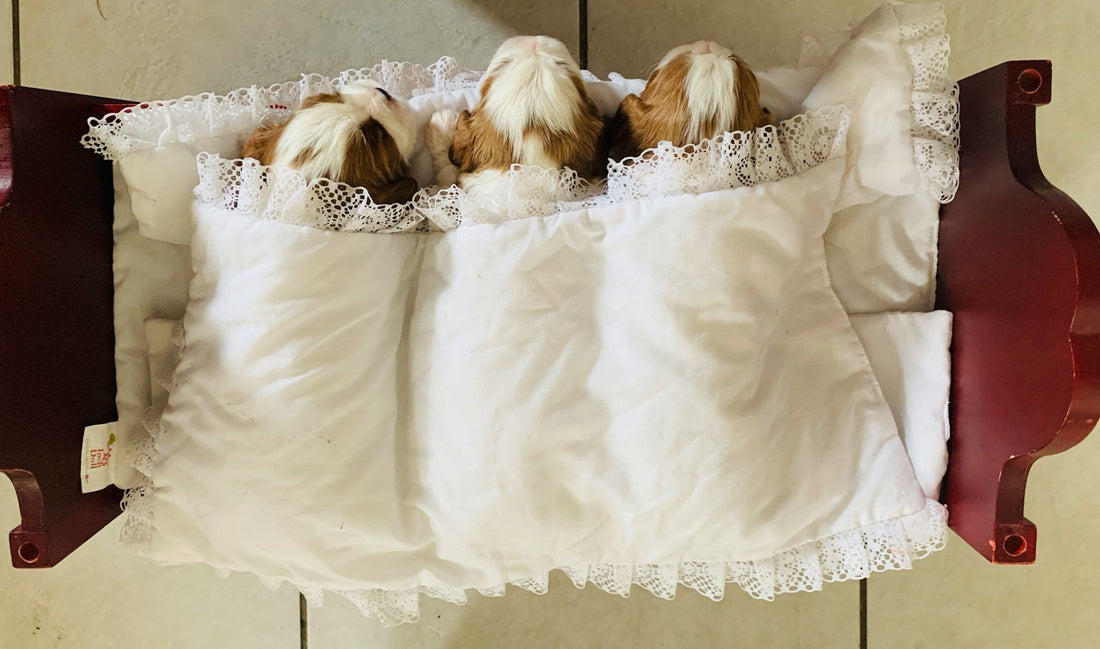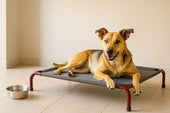Key Takeaways
-
Washing your dog's bed is crucial for hygiene, comfort, and flea control.
-
Different materials and styles of dog beds require different cleaning methods.
-
Regular cleaning helps reduce odor, allergens, and the risk of pests.
-
Natural deodorizing and flea-killing techniques can be safer and more effective than harsh chemicals.
-
This article provides step-by-step guides for machine-washable beds, beds without removable covers, and stuffed beds.
Introduction
Dog beds are more than just a cozy corner—they're your pet's safe space, nap station, and sometimes their go-to hideout. But these same features can also make dog beds a hotspot for dirt, hair, odors, and even fleas. Despite this, many dog owners are unsure how to properly clean a dog bed without damaging it or risking their pet’s health.
In this article, we’ll explore practical, science-backed strategies to clean dog beds correctly. We'll address various bed types, the best products to use, how to eliminate odors naturally, how often to clean, and why doing it right matters. Whether your dog’s bed is machine washable, heavily stuffed, or doesn’t have a removable cover, you’ll find step-by-step guidance here. If you’re looking to upgrade your pet’s sleeping space, consider browsing our dog bed collection for high-quality, washable options.
Why Cleaning Your Dog’s Bed Matters
Health & Hygiene
According to the NSF International, pet beds are among the top 10 dirtiest items in the home. They harbor bacteria like E. coli, salmonella, and MRSA. These pathogens can affect not only your pet but also you and your family. Frequent washing drastically reduces this microbial load.
Keeping your dog’s environment clean can also help prevent skin infections, hot spots, and allergic reactions that are often caused by contact with bacteria-laden surfaces. Particularly for dogs with allergies or weakened immune systems, a clean bed is part of maintaining overall wellness.
Pest Control
Fleas, mites, and ticks love to nest in warm, soft fabrics—especially those lined with pet fur and skin flakes. Regular washing helps kill flea eggs and disrupt the life cycle of common parasites.
If your dog has had fleas before, be sure to wash the bed at high temperatures and follow up with appropriate treatments to prevent re-infestation. Using flea-resistant covers can also be a helpful long-term strategy.
Odor Management
Dog beds soak up body oils, saliva, and sometimes even urine. Left unwashed, they emit unpleasant odors. Cleaning neutralizes these smells and creates a more inviting space for your dog.
Besides being unpleasant for humans, persistent odors may indicate mold or bacterial growth that could harm your dog. Regular washing and spot-treating not only eliminate these smells but can also prevent microbial buildup that contributes to poor indoor air quality.
Longevity of the Bed
Proper maintenance extends the lifespan of the bed and its materials. Washing incorrectly can cause seams to rip, stuffing to clump, and covers to shrink.
Investing in beds with removable covers and water-resistant liners can simplify cleaning and improve durability. Read care labels carefully and always follow recommended washing instructions to preserve your investment.
How to Wash a Dog Bed Without Ruining It?
Step-by-Step Guide
-
Vacuum first – Remove hair, dirt, and debris. Use a pet hair remover for deep cleaning.
-
Check the label – Follow manufacturer guidelines regarding water temperature and detergent.
-
Use pet-safe detergent – Avoid dyes, fragrances, and harsh chemicals.
-
Cold to warm wash – Hot water can damage fabric and stuffing.
-
Dry thoroughly – Damp bedding encourages mold. Air dry when possible, or use low heat in the dryer.
Pro tip: Place tennis balls in the dryer to fluff up stuffing.
Washing a dog bed is much like washing delicate human bedding, but with added consideration for odor, bacteria, and allergens. When in doubt, err on the side of caution and choose gentler methods. A lint roller before vacuuming can further reduce trapped fur and dander.
Can You Put Dog Beds in the Washing Machine?
Yes—But It Depends
Machine washing is safe for most dog beds with removable covers and washable fillings. However, beds with delicate stitching, foam inserts, or non-washable parts should be cleaned differently.
Some larger beds may not fit standard machines—consider using a commercial washer at a laundromat. Also, avoid overloading your washer, as the bed may absorb significant water weight, putting stress on your appliance.
Best Practice
-
Wash alone or with towels to balance the load.
-
Avoid fabric softener, which can irritate your dog's skin.
-
Use an extra rinse cycle to remove detergent residues.
PetMD notes that weekly washing of your dog’s bed can significantly reduce allergens in your home.
If you're unsure whether a bed is machine-safe, test a small area first or refer to online guides or manufacturer FAQs. When in doubt, hand-washing may be the safer route.
What’s the Best Way to Clean Dog Beds with Stuffing?
Beds filled with polyfill or foam require special care:
-
Spot clean stains first with an enzyme-based cleaner.
-
Soak in a bathtub with warm water and pet-safe detergent.
-
Press, don’t wring – Squeezing out water can distort the filling.
-
Lay flat to dry in a sunny, well-ventilated space.
Stuffed beds are prone to clumping, which affects comfort and support. After drying, manually fluff and shake the bed to redistribute filling evenly. For long-term care, consider rotating between two beds to allow one to fully dry while the other is in use.
Avoid submerging memory foam—spot clean instead. Use baking soda to deodorize. Check out our guide on choosing the perfect bed size to better suit your dog's needs.
How Often Should You Wash Your Dog’s Bed?
-
Weekly for active/outdoor dogs
-
Biweekly for indoor-only dogs
-
Immediately after illness, accidents, or flea infestation
According to a study by the American Kennel Club, over 40% of dog owners don’t wash their dog’s bed more than once a month—a habit that increases risk of odor buildup and skin irritation.
Dogs with allergies, senior dogs, or those with compromised immune systems may benefit from more frequent cleanings. Just like human bedding, freshness impacts quality of rest and health. Incorporate it into your regular cleaning routine.
Does Washing Dog Beds Kill Fleas and Bugs?
Yes—When Done Properly
Washing in warm water (60°C or 140°F) for 30 minutes kills adult fleas and larvae. However, flea eggs are more resistant.
For Full Effectiveness:
-
Follow up with a pet-safe flea spray after drying.
-
Treat the surrounding area: carpet, couch, and crate.
-
Regular vacuuming is essential.
CDC guidelines support integrated pest control involving both cleaning and treatment.
For severe infestations, pair cleaning with oral or topical flea treatments. Environmental sprays can target flea eggs hidden in furniture crevices or baseboards.
Can You Use Bleach on Dog Beds Safely?
Caution Advised
Bleach can be toxic to pets even after rinsing. It’s best avoided unless specifically recommended by the manufacturer.
Safer Alternatives:
-
White vinegar (natural disinfectant)
-
Baking soda (odor neutralizer)
-
Hydrogen peroxide (mild antiseptic)
If you must disinfect due to illness or contamination, try vinegar followed by a thorough rinse and drying in sunlight, which acts as a natural germicide. Always ensure beds are fully dry and free of chemical residue before allowing your dog to use them again.
How to Wash a Dog Bed Without a Removable Cover
Beds without removable covers require more effort, but they can still be thoroughly cleaned. Begin by vacuuming the entire surface to remove pet hair, crumbs, and loose dirt. For spot cleaning, use a pet-safe enzyme cleaner on any visible stains and allow it to sit for a few minutes before blotting with a damp cloth.
Next, submerge the bed in a bathtub or large basin filled with warm water and a mild detergent. Gently agitate the water to help the soap penetrate the fabric and stuffing. After soaking for 15–30 minutes, scrub the surface with a soft-bristled brush, focusing on stained or heavily soiled areas.
Rinse thoroughly multiple times to ensure all detergent is removed. Improper rinsing can leave residues that irritate your dog’s skin. Finally, squeeze out as much water as possible (without twisting or wringing) and lay the bed flat in a well-ventilated area or under direct sunlight to dry. Be patient—this process can take a full day or more depending on bed size and weather.
How to Get Rid of Odors from Dog Beds Naturally
Persistent odors are common in dog beds, especially those that aren’t washed frequently. Fortunately, natural remedies can help neutralize these smells without relying on synthetic fragrances that may bother your dog.
Start by sprinkling a generous amount of baking soda over the entire surface of the bed. Let it sit for 15–30 minutes, then vacuum it thoroughly. Baking soda helps absorb and neutralize acidic odors from pet dander and body oils.
For deeper deodorizing, lightly mist the bed with a 1:1 solution of white vinegar and water. Vinegar is a natural antibacterial agent and evaporates quickly, taking odors with it. Avoid using essential oils unless specifically approved for pets, as some (like tea tree or eucalyptus) can be harmful.
Activated charcoal pouches or odor-neutralizing sachets placed under or around the bed can also help keep smells at bay between washes. Regular sun-drying can refresh fabrics and eliminate lingering musty scents through natural UV sterilization.
Is It Safe to Put Dog Beds in the Dryer?
Drying a dog bed safely depends on its materials. Always check the care label first. Most fabric covers made from cotton or polyester are safe to tumble dry on low heat. However, foam inserts, orthopedic pads, or beds with non-removable covers may be damaged by heat and should be air-dried.
To speed up drying and maintain bed shape, add a few clean tennis balls or wool dryer balls to the dryer. This prevents clumping and helps fluff up the stuffing. Place an old towel alongside the bed to absorb excess moisture and reduce drying time.
Ensure the bed is completely dry before returning it to your dog. Dampness can lead to mold, mildew, and bacteria growth, all of which are hazardous to your pet’s health. If the bed is large or slow to dry, rotating between two beds can ensure your dog always has a clean and dry place to rest.
For beds that must be air-dried, placing them outside in the sun on a warm, dry day is ideal. Sunlight not only helps dry the bed faster but also acts as a natural disinfectant.
Conclusion
Keeping your dog’s bed clean isn’t just about tidiness—it’s a critical part of your pet’s overall health and comfort. By understanding the materials and construction of your dog’s bed, you can choose the safest and most effective cleaning method. Regular maintenance reduces the buildup of harmful bacteria, eliminates pests like fleas, and ensures that your dog’s favorite resting spot smells fresh and feels cozy.
From natural deodorizers to washing techniques tailored for different bed types, a well-maintained dog bed benefits both your pet and your household. Establish a regular cleaning routine and keep a backup bed handy so your furry friend is never without a comfortable place to sleep. And when in doubt, always go for pet-safe products and gentle methods.
If you’re considering upgrading to a more hygienic and easy-to-clean option, browse our best-rated dog beds designed for both comfort and convenience. Clean bed, happy dog, healthier home.




